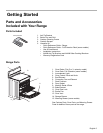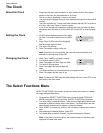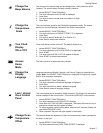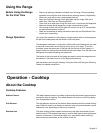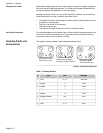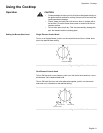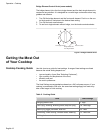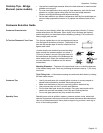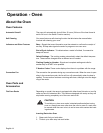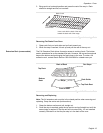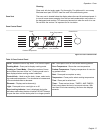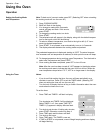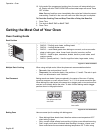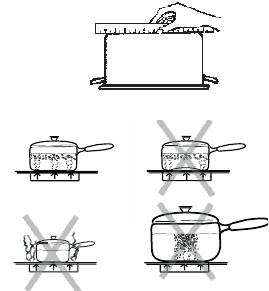
Operation - Cooktop
English 13
Cooktop Tips - Bridge
Element (some models)
• Use the front and bridge elements without the back element for medium sized
griddles and oval pots.
• For even heat distribution when using all three elements, start with the back
element at a slightly higher setting than the front and bridge elements.
Observe cooking performance and adjust accordingly.
• Set the back element at a different temperature than the front and bridge ele-
ments to keep prepared food warm or to prepare two different foods at one
time.
Cookware Selection Guide
Cookware Characteristics The choice of pans directly affects the cooking speed and uniformity. For best
results select pans with flat bases. When a pan is hot, the base (pan bottom)
should rest evenly on the surface without wobbling (rocking). Flat, medium-to-
heavy-weight pans are best.
To Test the Flatness of Your Pans Turn the pan upside down on the countertop and place a
ruler flat against the bottom of the pan. The bottom of the
pan and the straight edge of the ruler should be flush
against each other.
Another simple test to determine even heat distri-
bution across the cookware bottom is to place 1”
(25.4 mm) of water in the pan. Bring the water to a
boil and observe the location of the bubbles as the
water starts to boil. Good, flat cookware will have
an even distribution of bubbles over the bottom
surface area.
Matching Diameters – The base of the pan should cover or match the diameter
of the element being used. Pans may overhang the element area by 1" (25.4 mm)
all around.
Tight Fitting Lids – A lid shortens cooking time and water boils faster by holding
the heat inside the pan.
Cookware Tips • Use of pots and pans with rounded (either concave or convex) warped or
dented bottoms should be avoided. See drawings below.
• Make sure the bottom of the pot or pan being used is clean and dry.
• Use pots and pans with thick, smooth metal bottoms.
• Do not slide metal pots across the cooktop. Pans may leave marks which
need to be removed immediately. See Care and Cleaning Section.
• Do not use glass pans as they may scratch the surface.
Specialty Pans Specialty pans such as griddles, roasters, pressure cookers, woks, water bath
canners and pressure canners must have the same features as described above.
Use only a flat-bottomed wok. Never place a support ring, such as a wok ring or
trivet, on the cooking surface.



